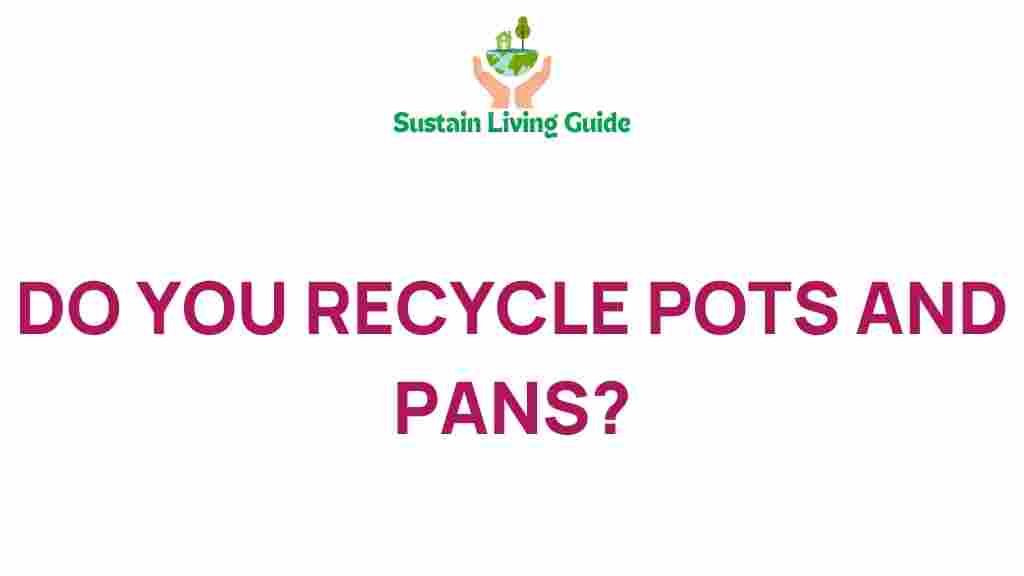Recycle: Uncovering the Hidden Truth About Pots and Pans
When it comes to recycling, many people are eager to do their part to protect the environment. However, there are common household items, like pots and pans, that often leave us questioning their recyclability. In this article, we’ll explore whether you can recycle pots and pans, the materials they’re made from, and the best practices for disposal. Let’s dive into the hidden truth about recycling these kitchen essentials!
Understanding the Materials
Before determining if you can recycle pots and pans, it’s essential to understand the materials they are made from. Here are some common types:
- Stainless Steel: Durable and non-reactive, stainless steel pots and pans are highly recyclable.
- Non-Stick Coatings: Many non-stick pans have a coating that can complicate the recycling process.
- Aluminum: Aluminum pots and pans can be recycled, but they must be clean and free of any food residues.
- Cast Iron: While cast iron is recyclable, it typically requires special handling due to its weight.
- Copper: Copper pots and pans are highly valuable in the recycling industry and can be recycled easily.
The Recycling Process for Pots and Pans
If you’ve established that your pots and pans are made from recyclable materials, you can follow this step-by-step process to recycle them properly:
Step 1: Check Local Regulations
Before recycling, it’s crucial to check your local recycling program guidelines. Not all municipalities accept pots and pans for recycling, so verify with your local waste management.
Step 2: Clean Your Pots and Pans
To ensure successful recycling, clean your pots and pans thoroughly. Remove food residues, grease, and any other contaminants. A clean item is more likely to be accepted in the recycling stream.
Step 3: Remove Non-Recyclable Parts
If your pot or pan has non-recyclable parts, such as plastic handles or lids, remove them carefully. These components can hinder the recycling process.
Step 4: Find a Recycling Center
Locate a recycling center or drop-off facility that accepts pots and pans. You can find information on local recycling programs through resources like Earth911.
Step 5: Drop Off Your Items
Once you’ve cleaned and prepared your pots and pans, drop them off at the recycling facility. Make sure to follow any instructions provided by the center.
What to Do if You Can’t Recycle Pots and Pans
In some cases, you might find that your local recycling program does not accept pots and pans. Here are alternative options:
- Donate: If your pots and pans are still in usable condition, consider donating them to local charities, shelters, or thrift stores.
- Upcycle: Get creative and transform old pots and pans into planters or garden art. This not only prevents waste but also adds charm to your outdoor space.
- Repurpose: Use old cookware for non-food-related purposes, such as storage containers, bird feeders, or even as unique home décor.
Troubleshooting Common Recycling Issues
Despite your best intentions, you might encounter some challenges when trying to recycle pots and pans. Here’s how to troubleshoot common issues:
Issue 1: Non-Recyclable Materials
If your pots and pans have materials that are not accepted, like certain non-stick coatings, consider alternative disposal methods:
- Check with your local waste management for safe disposal options.
- Research specialized recycling programs that accept these materials.
Issue 2: Local Restrictions
If your area does not accept pots and pans, you can:
- Contact your local waste authority to suggest a change in their recycling policy.
- Advocate for better recycling options in your community.
Issue 3: Difficulty in Cleaning
If you struggle to clean your pots and pans for recycling:
- Soak them in hot, soapy water to loosen food residues.
- Use a scrubber or brush for tough stains.
Conclusion: The Path to Sustainable Living
In conclusion, recycling pots and pans is not as straightforward as it may seem. However, by understanding the materials, following the recycling process, and exploring alternative options if necessary, you can contribute to a more sustainable environment. Remember, every little step counts in reducing waste and conserving resources.
For more information on recycling practices, visit Recycling.org and stay informed about how you can make a difference in your community.
As you continue your recycling journey, keep in mind that the goal is to minimize waste and promote sustainable living. Whether through recycling, donating, or repurposing, your efforts can help pave the way for a healthier planet.
This article is in the category Waste and created by SustainLivingGuide Team
